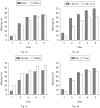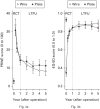Percutaneous fixation with Kirschner wires versus volar locking-plate fixation in adults with dorsally displaced fracture of distal radius: five-year follow-up of a randomized controlled trial
- PMID: 31362548
- PMCID: PMC6681675
- DOI: 10.1302/0301-620X.101B8.BJJ-2018-1285.R1
Percutaneous fixation with Kirschner wires versus volar locking-plate fixation in adults with dorsally displaced fracture of distal radius: five-year follow-up of a randomized controlled trial
Abstract
Aims: The aim of this study was to compare the clinical effectiveness of Kirschner wire (K-wire) fixation with locking-plate fixation for patients with a dorsally displaced fracture of the distal radius in the five years after injury.
Patients and methods: We report the five-year follow-up of a multicentre, two-arm, parallel-group randomized controlled trial. A total of 461 adults with a dorsally displaced fracture of the distal radius within 3 cm of the radiocarpal joint that required surgical fixation were recruited from 18 trauma centres in the United Kingdom. Patients were excluded if the surface of the wrist joint was so badly displaced it required open reduction. In all, 448 patients were randomized to receive either K-wire fixation or locking-plate fixation. In the K-wire group, there were 179 female and 38 male patients with a mean age of 59.1 years (19 to 89). In the locking-plate group, there were 194 female and 37 male patients with a mean age of 58.3 years (20 to 89). The primary outcome measure was the patient-rated wrist evaluation (PRWE). Secondary outcomes were health-related quality of life using the EuroQol five-dimension three-level (EQ-5D-3L) assessment, and further surgery related to the index fracture.
Results: At 12 months, 402/448 participants (90%) recruited into the main study provided PRWE scores. At year two, 294 participants (66%) provided scores; at year five, 198 participants (44%) provided scores. There was no clinically relevant difference in the PRWE at any point during the five-year follow-up; at five years, the PRWE score was 8.3 (12.5) in the wire group and 11.3 (15.6) in the plate group (95% confidence interval -6.99 to 0.99; p = 0.139). Nor was there a clinically relevant difference in health-related quality of life. Only three participants had further surgery in the five years after their injury (one in the wire group and two in the plate group).
Conclusion: This follow-up study continues to show no evidence of a difference in wrist pain, wrist function, or quality of life for patients treated with wires versus locking plates in the five years following a dorsally displaced fracture of the distal radius. Cite this article: Bone Joint J 2019;101-B:978-983.
Keywords: Distal radius; Kirschner wire; Locking plate; Long-term; Randomized controlled trial.
Figures



Similar articles
-
Percutaneous fixation with Kirschner wires versus volar locking plate fixation in adults with dorsally displaced fracture of distal radius: randomised controlled trial.BMJ. 2014 Aug 5;349:g4807. doi: 10.1136/bmj.g4807. BMJ. 2014. PMID: 25096595 Free PMC article. Clinical Trial.
-
Moulded cast compared with K-wire fixation after manipulation of an acute dorsally displaced distal radius fracture: the DRAFFT 2 RCT.Health Technol Assess. 2022 Feb;26(11):1-80. doi: 10.3310/RLCF6332. Health Technol Assess. 2022. PMID: 35152940 Free PMC article. Clinical Trial.
-
Are Volar Locking Plates Superior to Percutaneous K-wires for Distal Radius Fractures? A Meta-analysis.Clin Orthop Relat Res. 2015 Sep;473(9):3017-27. doi: 10.1007/s11999-015-4347-1. Epub 2015 May 16. Clin Orthop Relat Res. 2015. PMID: 25981715 Free PMC article. Review.
-
UK DRAFFT - a randomised controlled trial of percutaneous fixation with kirschner wires versus volar locking-plate fixation in the treatment of adult patients with a dorsally displaced fracture of the distal radius.BMC Musculoskelet Disord. 2011 Sep 13;12:201. doi: 10.1186/1471-2474-12-201. BMC Musculoskelet Disord. 2011. PMID: 21914196 Free PMC article. Clinical Trial.
-
Volar locking plates versus K-wire/pin fixation for the treatment of distal radial fractures: a systematic review and quantitative synthesis.Br Med Bull. 2015 Sep;115(1):91-110. doi: 10.1093/bmb/ldv015. Epub 2015 Apr 26. Br Med Bull. 2015. PMID: 25918348
Cited by
-
Displaced distal radius fracture: reduction, follow-up, and clinical outcomes : learning from a pragmatic approach during the 2020 COVID-19 lockdown transition.Bone Jt Open. 2021 May;2(5):338-343. doi: 10.1302/2633-1462.25.BJO-2021-0015.R1. Bone Jt Open. 2021. PMID: 34044581 Free PMC article.
-
Predicting fracture outcomes from clinical registry data using artificial intelligence supplemented models for evidence-informed treatment (PRAISE) study protocol.PLoS One. 2021 Sep 23;16(9):e0257361. doi: 10.1371/journal.pone.0257361. eCollection 2021. PLoS One. 2021. PMID: 34555069 Free PMC article.
-
Reduction Loss Despite Adequate Volar Locking Plate Fixation in Distal Radius Fractures: Analysis of Characteristics and Follow-up Management.Clin Orthop Surg. 2025 Jun;17(3):478-487. doi: 10.4055/cios24197. Epub 2025 Apr 18. Clin Orthop Surg. 2025. PMID: 40454136 Free PMC article.
-
Management of Distal Radius Fractures: Comparison of Three Methods.Cureus. 2020 Aug 19;12(8):e9875. doi: 10.7759/cureus.9875. Cureus. 2020. PMID: 32963915 Free PMC article.
-
Forecasting effects of "fast-tracks" for surgery in the Swedish national guidelines for distal radius fractures.PLoS One. 2022 Feb 10;17(2):e0260296. doi: 10.1371/journal.pone.0260296. eCollection 2022. PLoS One. 2022. PMID: 35143508 Free PMC article.
References
-
- Costa ML, Achten J, Plant C, et al. . UK DRAFFT: a randomised controlled trial of percutaneous fixation with Kirschner wires versus volar locking-plate fixation in the treatment of adult patients with a dorsally displaced fracture of the distal radius. Health Technol Assess 2015;19:1–124. - PMC - PubMed
-
- Tubeuf S, Yu G, Achten J, et al. . Cost effectiveness of treatment with percutaneous Kirschner wires versus volar locking plate for adult patients with a dorsally displaced fracture of the distal radius: analysis from the DRAFFT trial. Bone Joint J 2015;97-B:1082–1089. - PubMed
-
- Costa ML, Jameson SS, Reed MR. Do large pragmatic randomised trials change clinical practice?: assessing the impact of the distal radius acute fracture fixation trial (DRAFFT). Bone Joint J 2016;98-B:410–413. - PubMed
-
- Fullilove S, Gozzard C. Dorsally displaced fractures of the distal radius: a critical appraisal of the DRAFFT (distal radius acute fracture fixation trial) study. Bone Joint J 2016;98-B:298–300. - PubMed

